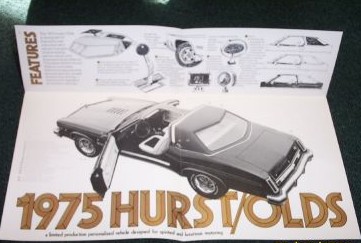 | As far as I know, it all started with the 442 Hurst-Oldsmobiles. Hurst used to convert the Olds 442 into a terrific, flashy luxury hot rod. When Olds stopped making 442 convertibles in 1973, Hurst wanted to help keep the "fun factor" strong. The Hurst Olds was a G-body (Cutlass Supreme, Grand Prix, etc.) at that point, so the first ones were designed for the G-body, and fit the A-body as well. These had silver aluminum frames and a brownish or gold tint, and came out in 1975. |
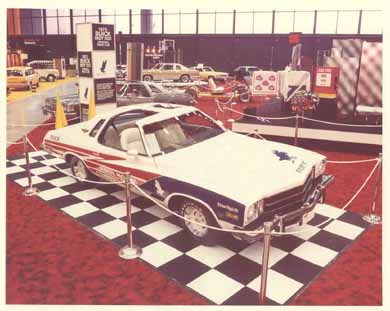 | Buick also got into the act. In 1975, they paced the Indy 500 with a so-called Century (They called their G body every name you can think of before settling on "Regal"), shown here at the 1975 Chicago Auto Show. The t-tops were important, as the Indianapolis Motor Speedway required their pace car to be a convertible. Convertibles were fading away (Hurst had been forced to saw the roof off the 74 Hurst-Olds pace car). In the marketplace, it was pretty clear that Hatch roofs were becoming a desirable alternative, not only for Indy, but for drivers everywhere seeking some open-air fun. |
Next, it was Pontiac's turn. In 1976, Pontiac used Hurst Hatches to make its Limited Edition 50th anniversary Pontiac Grand Prixs, and apparently they decided rather late to make some Trans Ams also. This was the beginning of F-body T-tops, and it was also the beginning of Special Edition Trans Ams, made famous by "Smokey and the Bandit" and discussed on Hoghead's Bandit Page. Both would prove very popular.
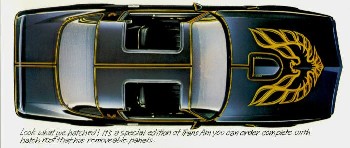 | 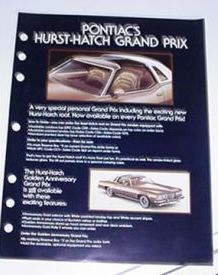 |
| It would be Pontiac that would crank up the volume on something that wasn't a limited edition. In 1977, as Firebird popularity exploded, Pontiac made Hurst Hatches available on all Firebird models (and Grand Prixs too). Regular cars got silver frames like Hurst had always manufactured. Special Edition Trans Am Hurst Hatches were made with chemically blackened frames and black tinted safety glass, making them appear monochromatic on a black Trans Am (shown above and below). Both colors are shown on this page somewhat randomly.

In 1977-78, the Firebird hatch created quite a large business for Hurst, who installed hatches in, I would guess, 50,000 or more brand new cars. | 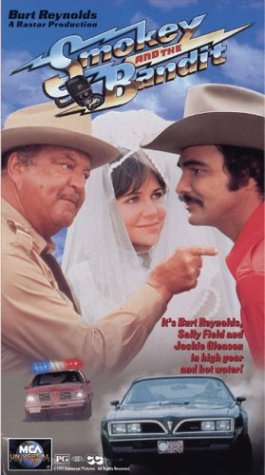 |
| They managed to advertise for even more business about this time, but it's unclear whether they really had much of a network of installers. This is a pretty cool looking ad, so I've put a big file here for download. | click on the image for a larger version
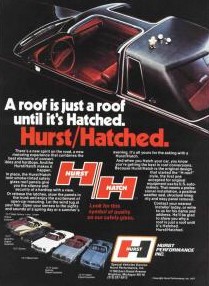 |
|
Because of water leaks, there was a major design revision on both G-body and F-body roof frames and weatherstripping. Everybody calls this first and second design, and it's a REALLY important distinction when you order weatherstripping. There were also some minor design revisions on the G-body T-tops, and these are well-covered in the manual that we sell (right). The cars were recalled for installation of the second design, but recall procedures were pretty lame in the 70's, so less than half of the cars were actually retrofitted. | 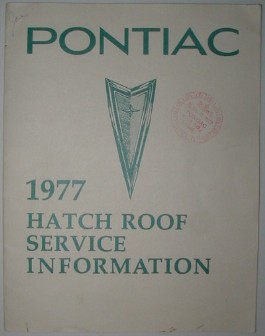 |
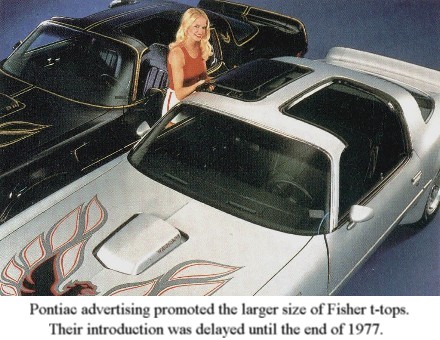 |
Based on the success of the 1977 Hurst Hatch roof, GM's Fisher body division set about designing their own t-top roof for installation on the assembly line. A 1978 introduction was planned, but the tops were delayed for the first half of the model year, and Hurst t-tops came back to fill the gap.
When the Fisher t-tops reached full production, the Hurst t-tops option was cancelled. This was around February of 1978. I used to think that new 1978 Firebirds switched to the recalled version during production, but I've changed my mind. We've found several cars built close to the cancellation time with first-design tops. |
| After the F-body boom, Hurst continued in the hatch business, making hatches for other cars and taking a supplier contract for the very popular 1978-87 GM G-body t-tops. During this time, Hurst was acquired by Cars & Concepts. In 1988, C&C converted solid-roof Fieros to t-tops at Brighton Michigan, where the old Special Edition Trans Ams had been converted. Hurst (the company) was already gone, and the Fiero would be, too, at the end of the year. As far as I can tell, the hatch business died out with the end of the G-body and Fiero. If anybody has any more info to add to this history, I'd very much appreciate your help. |








